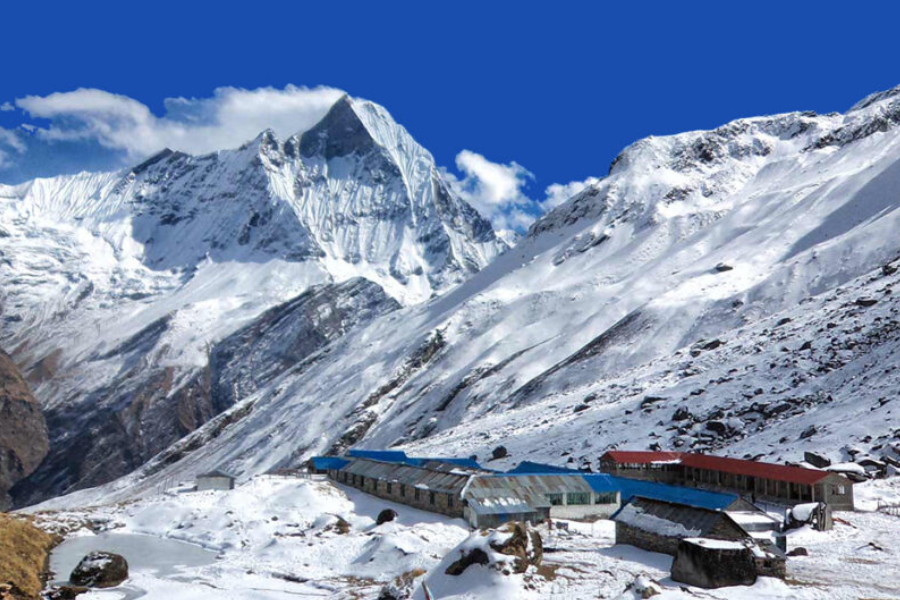The History and Legends of Annapurna Base Camp
The history and legends of Annapurna Base Camp are as captivating as the trek itself, weaving together tales of ancient cultures, divine myths, and the storied exploration of the Himalayas. The Annapurna region, named after the Hindu goddess Annapurna, is steeped in spiritual significance and historical lore. Annapurna, which translates to “full of food” or “provider of sustenance,” is revered as the goddess of harvests and nourishment. Her name is synonymous with the bounty and fertility of the land, reflecting the deep connection between the local people and their environment.
The Annapurna massif, a series of peaks including Annapurna I, the 10th highest mountain in the world, has long been a focal point of local legends and religious reverence. According to Hindu mythology, Annapurna is a manifestation of the goddess Parvati, consort of Shiva, who descended to Earth to provide sustenance and nourishment to humankind. This divine association lends the Annapurna region a sacred aura, making it a site of pilgrimage and spiritual significance for many.
Historically, the Annapurna region has been a crucial trade route connecting Nepal with Tibet and India. The ancient trails, which trekkers now traverse, were once bustling paths for traders and pilgrims, facilitating the exchange of goods and cultural practices. These routes played a significant role in shaping the cultural and economic landscape of the region, influencing everything from local customs to architectural styles.
In the 20th century, the Annapurna Base Camp Trek gained prominence as a major destination for trekkers and mountaineers. The massif attracted international attention when it became the site of some of the earliest and most challenging climbing expeditions in the Himalayas. The first successful ascent of Annapurna I was achieved by the French team led by Maurice Herzog and Louis Lachenal in 1950, marking a historic milestone in mountaineering. Their journey, fraught with extreme challenges and hardships, cemented Annapurna’s reputation as one of the most formidable peaks in the world.
The stories of explorers and climbers who have ventured into the Annapurna region further enrich its legend. These adventurers often recount encounters with the formidable beauty and harsh conditions of the mountains, contributing to the mystique and allure of the Annapurna Base Camp. Their experiences highlight both the grandeur and the perils of the region, capturing the imagination of future trekkers and climbers.
Today, the Annapurna Base Camp stands as a testament to both its rich historical heritage and its evolving role as a key destination in the trekking world. The blend of ancient legends, spiritual significance, and modern exploration continues to draw visitors from around the globe, each seeking to connect with the profound history and beauty of this extraordinary region.
Introduction to Annapurna Base Camp
Annapurna Base Camp, located in the heart of the Himalayas in Nepal, is a renowned trekking destination that offers an immersive experience into the grandeur of the Annapurna massif. Situated at an altitude of approximately 4,130 meters (13,550 feet), the base camp serves as the focal point of the Annapurna Base Camp Trek, a journey celebrated for its stunning natural beauty and cultural richness. The trek to Annapurna Base Camp typically spans 10 to 14 days, depending on the chosen route and pace. It provides trekkers with a unique opportunity to explore diverse landscapes, from lush subtropical forests to alpine meadows and rugged terrain, all while being surrounded by some of the highest peaks in the world. The trek is accessible to a wide range of trekkers, from seasoned adventurers to those with moderate fitness levels, making it a popular choice for those seeking both a challenging and rewarding Himalayan experience. The base camp itself offers a breathtaking panorama of the Annapurna range, including Annapurna I, Annapurna South, and Machapuchare, providing a dramatic and awe-inspiring backdrop that leaves a lasting impression on all who visit.
Geographic Overview
The Annapurna Base Camp is situated in the Annapurna Conservation Area in central Nepal, a region renowned for its diverse geography and dramatic landscapes. The Annapurna massif, which includes several of the world’s highest peaks, forms the geographical centerpiece of this area. The massif stretches approximately 55 kilometers (34 miles) from east to west and rises to over 8,000 meters (26,247 feet) at Annapurna I, the tenth highest mountain in the world. The trek to Annapurna Base Camp navigates a variety of terrains, from the subtropical lowlands of the Pokhara Valley to the high-altitude alpine zone of the base camp itself. The route traverses through terraced fields, lush forests, and rocky paths, offering a dynamic and ever-changing landscape. As trekkers ascend, they encounter the dramatic transition from green valleys and flowing rivers to rugged cliffs and snow-capped peaks. The geographic diversity of the region not only enhances the visual appeal of the trek but also contributes to the unique environmental and climatic conditions encountered along the way.
Early Exploration of the Region
The Annapurna region has been a site of significant exploration and adventure since the early 20th century. Initial interest in the region was sparked by the daunting challenges presented by the Annapurna massif, which became a focal point for mountaineers and explorers. The early exploration of Annapurna began with expeditions aimed at mapping and surveying the area, often involving difficult and perilous journeys through uncharted terrain. One of the most notable early expeditions was the French-led team’s attempt to summit Annapurna I. In 1950, Maurice Herzog and Louis Lachenal achieved the first successful ascent of Annapurna I, a landmark achievement in the history of mountaineering. Their expedition was marked by extraordinary bravery and resilience, as they faced harsh weather conditions and technical difficulties. The success of this expedition not only brought global attention to the Annapurna range but also set a precedent for future explorations in the Himalayas. The stories of these early explorers highlight the remarkable challenges and triumphs of venturing into one of the most formidable mountain ranges in the world.
Significance of the Annapurna Range
The Annapurna Range holds immense significance both geographically and culturally. Geographically, it is one of the most formidable mountain ranges in the world, featuring some of the highest peaks on the planet. The range includes Annapurna I, Annapurna II, Annapurna III, Annapurna IV, and several other towering peaks, each contributing to the region’s dramatic topography. The Annapurna massif is renowned for its challenging climbing routes and its role in the history of high-altitude mountaineering. The range’s significance extends beyond its physical grandeur; it is a vital part of Nepal’s natural heritage and a crucial component of the Annapurna Conservation Area. Culturally, the Annapurna Range holds sacred status in Hinduism and is associated with the goddess Annapurna, who is worshipped as the deity of nourishment and abundance. The peaks are revered as divine manifestations, and the region’s cultural practices and local traditions are deeply intertwined with these spiritual beliefs. The Annapurna Range, therefore, stands as a symbol of both natural majesty and spiritual significance, drawing trekkers and pilgrims alike to experience its profound beauty and sacred presence.
Local Myths and Legends
The Annapurna region is rich with local myths and legends that add a mystical dimension to the trek. Central to the area’s lore is the figure of Annapurna, a Hindu goddess who is considered the goddess of food and harvest. According to mythology, Annapurna is a manifestation of the goddess Parvati, the consort of Shiva. Her name means “full of food” and symbolizes the provision of sustenance and abundance. Local legends describe the Annapurna massif as sacred, with the towering peaks being viewed as divine entities. The mountain range is often depicted as the abode of gods, where their presence is felt through the majesty of the peaks and the surrounding natural beauty. These myths also extend to the local cultures and communities, influencing their traditions, festivals, and daily life. Stories of divine encounters and spiritual significance imbue the Annapurna region with a sense of reverence and mystery. The interplay of these legends with the breathtaking landscapes adds an enriching layer to the trekking experience, offering trekkers not only a physical journey but also a connection to the region’s deep cultural and spiritual heritage.
Cultural Influences on Trekking
Cultural influences play a significant role in shaping the experience of trekking in the Annapurna region, reflecting a blend of local traditions, religious practices, and historical practices. The Annapurna Base Camp Trek passes through diverse villages inhabited by ethnic groups such as the Gurung, Magar, and Thakali, each contributing unique cultural elements to the trek. Traditional architecture, local festivals, and daily customs encountered along the way provide trekkers with an immersive cultural experience. Local hospitality is a central aspect of the trek, with village teahouses offering a glimpse into the daily lives and traditions of the mountain communities. Additionally, cultural practices such as prayer flags, mani walls, and chortens (Buddhist stupas) encountered along the trail reflect the spiritual significance of the region. These elements, along with the opportunity to interact with local people and participate in cultural rituals, enhance the trekking experience by connecting visitors to the rich cultural heritage of the Annapurna region. This cultural immersion is integral to understanding the region’s historical and spiritual significance, making the trek a journey through both natural beauty and cultural depth.
Notable Expeditions
The Annapurna region has been the site of several notable expeditions that have marked significant milestones in the history of mountaineering. The most famous of these is the 1950 French expedition led by Maurice Herzog and Louis Lachenal, which achieved the first successful ascent of Annapurna I, the tenth highest peak in the world. This historic expedition was notable not only for its success but also for the extreme challenges faced, including severe weather conditions and high altitudes. The expedition’s account, including the harrowing descent and the loss of fingers and toes to frostbite, remains a seminal story in mountaineering literature. Other significant expeditions have included attempts on Annapurna’s other peaks and subsequent climbs by various international teams. Each expedition has contributed to the evolving understanding of the region’s climbing challenges and has added to the rich tapestry of Annapurna’s mountaineering history. These expeditions have cemented Annapurna’s reputation as one of the most challenging and revered climbing destinations in the world.
Historical Climbing Attempts
Historical climbing attempts in the Trek to Annapurna base Camp reveal both the allure and the formidable nature of the massif. The early attempts to climb Annapurna I, starting in the early 20th century, were marked by significant challenges due to the mountain’s technical difficulty and unpredictable weather conditions. The first successful ascent by Maurice Herzog and Louis Lachenal in 1950 was a groundbreaking achievement, but it was preceded by several unsuccessful attempts by other climbers. These early expeditions often faced extreme cold, high altitudes, and difficult terrain, which contributed to the mountain’s reputation for being one of the most challenging peaks to climb. Subsequent attempts on Annapurna’s other summits, such as Annapurna II and Annapurna III, also highlighted the technical and environmental difficulties inherent in climbing the massif. Historical records of these attempts provide valuable insights into the evolution of mountaineering techniques and the growing understanding of high-altitude climbing challenges. They also underscore the perseverance and bravery of early climbers who ventured into one of the most daunting and awe-inspiring regions of the Himalayas.
Sacred Sites and Spiritual Beliefs
The Annapurna region is imbued with sacred significance, deeply rooted in local spiritual beliefs and practices. The Annapurna massif is revered in Hinduism and Buddhism, with Annapurna I and the surrounding peaks considered sacred. According to Hindu mythology, Annapurna is the goddess of nourishment and abundance, an incarnation of Parvati, the consort of Shiva. Her divine presence is believed to bless the region with fertility and sustenance. Pilgrims and trekkers often encounter sacred sites such as prayer flags, mani stones, and chortens along the trek, which serve as markers of spiritual devotion and respect. These elements are not merely decorative but are integral to the local religious practices, representing prayers and offerings made to deities and spirits. The spiritual significance of the Annapurna region adds a profound dimension to the trekking experience, as trekkers traverse landscapes steeped in religious history and cultural reverence. The sense of spirituality enhances the trek, making it a journey that connects not only with nature but also with the deep-rooted spiritual heritage of the Himalayas.
Impact of Tourism on Local History
The influx of tourism in the Annapurna region has had a profound impact on the local history and cultural dynamics. Since the establishment of trekking routes and the growing popularity of the Annapurna Base Camp Trek, the region has experienced significant changes in its social and economic landscape. Tourism has brought increased economic opportunities to local communities, providing livelihoods through services such as trekking guides, porters, and hospitality businesses. However, this economic boost has also led to challenges, including the commercialization of traditional practices and the environmental impact of increased foot traffic. The preservation of local culture and heritage amidst the pressures of tourism has become a crucial consideration. Efforts are being made to balance the benefits of tourism with the need to protect and respect the local traditions and environment. Initiatives such as responsible tourism practices and community-based conservation projects aim to mitigate negative impacts and ensure that tourism supports sustainable development while preserving the rich cultural and historical legacy of the Annapurna region.
Preservation of Cultural Heritage
Preserving the cultural heritage of the Annapurna Base Camp Hike is a vital aspect of maintaining the unique character and traditions of this Himalayan enclave. As tourism grows, balancing the influx of trekkers with the preservation of local cultures and customs becomes increasingly important. Efforts to safeguard cultural heritage include initiatives to protect traditional architecture, promote local craftsmanship, and support community festivals. Local organizations and government bodies are actively involved in these preservation efforts, encouraging responsible tourism practices that respect and celebrate the region’s cultural assets. Additionally, educational programs aim to raise awareness among tourists about the significance of cultural heritage and the importance of maintaining respectful interactions with local communities. By integrating cultural preservation with sustainable tourism, the Annapurna region seeks to ensure that its rich traditions, languages, and practices continue to thrive amidst modern developments. This approach helps to protect the unique cultural identity of the Annapurna region while allowing visitors to experience its heritage in an authentic and respectful manner.
Stories of Sherpa Guides
Sherpa guides play an indispensable role in the Annapurna Base Camp Trek, and their stories are integral to the rich tapestry of the region’s mountaineering history. The Sherpas, an ethnic group native to the Himalayas, are renowned for their expertise in high-altitude trekking and climbing. Their deep knowledge of the mountains, combined with their resilience and cultural traditions, has made them essential partners for trekkers and climbers. Many Sherpas have become legendary figures in the mountaineering community due to their remarkable achievements and personal stories. These include tales of bravery, endurance, and the vital support they provide to climbers facing the challenges of the high Himalayas. The contributions of Sherpa guides extend beyond their professional roles; they embody a spirit of hospitality, guidance, and cultural stewardship. Their stories often reflect a profound connection to the mountains and a dedication to preserving the traditions of their ancestors while embracing the evolving dynamics of modern trekking.
The Role of Annapurna in Nepalese Identity
The Annapurna massif holds a profound place in Nepalese identity, symbolizing both national pride and cultural heritage. As one of the most iconic mountain ranges in Nepal, Annapurna is central to the country’s image and cultural narrative. The name “Annapurna” itself is derived from the Hindu goddess of nourishment, reflecting the spiritual significance of the mountains in Nepalese culture. The majestic peaks of Annapurna are not only a source of natural beauty but also a representation of resilience, strength, and the deep connection between the people and their environment. The Annapurna region’s prominence in Nepalese identity is reflected in local folklore, religious practices, and national symbols. The mountains are celebrated in festivals, artistic expressions, and traditional stories that reinforce their significance. This strong sense of identity fosters a deep respect for the Annapurna range and ensures its place as a symbol of both cultural pride and national heritage.
Contemporary Legends and Anecdotes
Contemporary legends and anecdotes surrounding the Annapurna region, ABC Trek continue to capture the imagination of trekkers and climbers. These modern stories often revolve around the extraordinary experiences of adventurers, the challenges faced during expeditions, and the remarkable achievements of those who venture into this formidable terrain. From tales of near-mythical encounters with elusive wildlife to accounts of triumph and perseverance in the face of adversity, these contemporary legends add a dynamic layer to the region’s storied history. Anecdotes of personal transformation and awe-inspiring vistas also contribute to the rich tapestry of modern narratives. These stories, shared by trekkers, climbers, and local residents, enrich the experience of exploring Annapurna, offering insights into the personal and collective significance of the mountains. They reflect the enduring allure of the Annapurna range and its ability to inspire awe and wonder in those who journey through its breathtaking landscapes.
Conclusion: The Enduring Legacy of Annapurna
The Annapurna region’s enduring legacy is a testament to its profound impact on both those who visit and those who call it home. This legacy encompasses not only the natural beauty and challenging terrain of the Annapurna massif but also the rich cultural, spiritual, and historical narratives that define the region. The Annapurna Base Camp Trek continues to be a symbol of adventure and exploration, attracting trekkers from around the world who seek to connect with its majestic landscapes and vibrant cultural heritage. The preservation of cultural traditions, the stories of Sherpa guides, and the region’s role in Nepalese identity all contribute to the depth and complexity of its legacy. Contemporary legends and anecdotes further enrich the narrative, ensuring that the mystique and allure of Annapurna remain alive and relevant. As both a natural wonder and a cultural icon, Annapurna’s legacy endures, inspiring awe, respect, and a deep appreciation for the extraordinary beauty and heritage of the Himalayas.
Stay connected for the latest news and updates on brainrusher

![[img]https://lookpic.com/cdn/i2/s/05282024182719-001.jpg[/img]](https://brainrusher.com/wp-content/uploads/2024/08/Add-a-heading-29-768x512.png)




